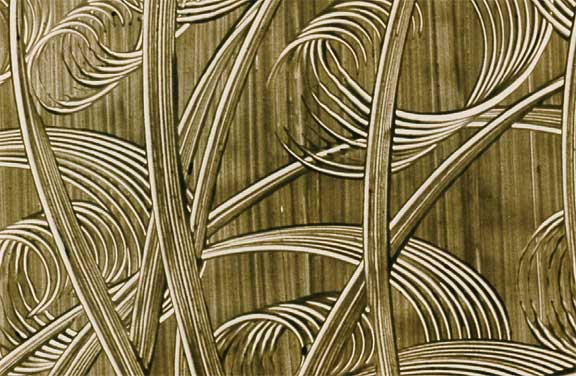Historical Paper Collections
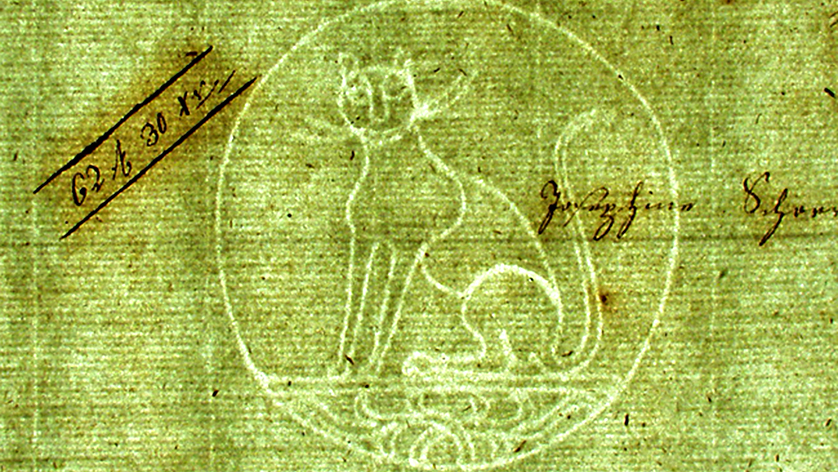
The Historical Paper Collections contain a large number of papers from pre-industrial times, factory-produced papers and papers created by artists. In 1901, the German Museum of Books and Writing acquired the first selection of coloured papers from Karl Theodor Weiss, thus laying the foundations for this special collection. The artefacts – unfinished and finished papers, a number of which show signs of use – mostly come from Europe, although there are also some from Asia and America. We are constantly adding to and expanding all parts of our collection.
Watermark collection
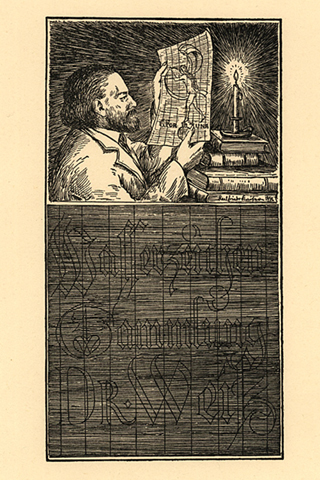 Bookplates belonging to paper historian and watermark researcher Dr. Karl Theodor Weiss (1872–1945), seen here viewing his collection.
Photo: DNB, Frieder Schmidt
Bookplates belonging to paper historian and watermark researcher Dr. Karl Theodor Weiss (1872–1945), seen here viewing his collection.
Photo: DNB, Frieder Schmidt
With more than 400,000 items, our collection of watermarks is the biggest of its kind in the world. In 1897, Karl Theodor Weiss (1872–1945) began collecting watermarks according to scientific criteria. His son Wisso Weiss (1904–1991) offered these collections in 1957 for sale. They were purchased by the German Paper Museum in Greiz (Thuringia). In 1964, the museum’s holdings became the property of the German Museum of Books and Writing at the German National Library.
The collections contain both original papers and reproductions of watermarks (copies or traced by hand). They are used as the basis for authenticity checks and for determining the age and origin of papers.
Further Information
Other items in our watermark collection
Collection of paper samples
The collection of paper samples encompasses modern handmade papers and individual samples of industrially produced papers from more than 600 paper manufacturers in Germany and abroad.
Along with graphic papers (writing, printing and drawing papers), the collection contains a large number of technical and other special papers. The sheer variety of the collection clearly shows how new types of paper are created in response to changing social requirements.
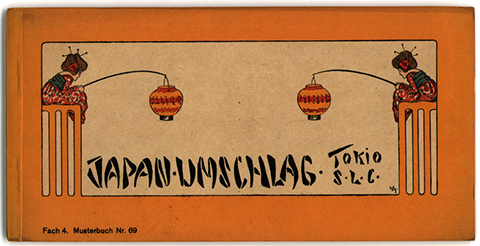 Sample book from the paper wholesaler S. L. Cahen. c. 1925. The book contains 12 samples of coloured paper.
Photo: DNB, Frieder Schmidt
Sample book from the paper wholesaler S. L. Cahen. c. 1925. The book contains 12 samples of coloured paper.
Photo: DNB, Frieder Schmidt
The extensive collection of sample books includes samples from paper manufacturers, paper finishers, paper processors, wholesalers and the supply industry. The sample books are used as customer information and illustrate for example the quality, colour, surface structure, grammage and printability of the paper.
The sample cards and sample books document how paper and cardboard developed to reflect changes in functional requirements, ecological standards and artistic taste, thus serving as a source for cultural history and the history of everyday objects.
Sample room at the Weissenborn paper factory
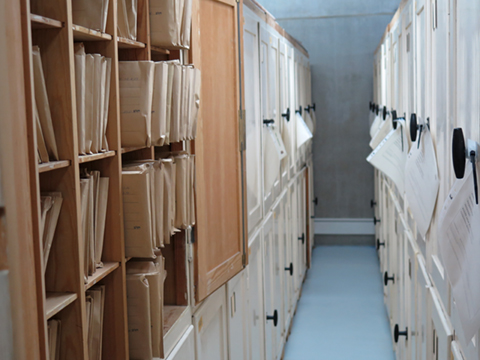 A look in the cupboards of the Weissenborn paper factory’s sample room, preserved in the stacks of the German Museum of Books and Writing.
Photo: DNB, Cornelia Ranft
A look in the cupboards of the Weissenborn paper factory’s sample room, preserved in the stacks of the German Museum of Books and Writing.
Photo: DNB, Cornelia Ranft
In summer 1994, the Weissenborn paper factory handed over the entire contents of its sample room to the German Museum of Books and Writing. It consists of samples dating in particular from 1950 to 1990 and is filed by commission number (year/serial number) in the original cupboards. The collection is catalogued by paper type and client.
Collection of coloured papers
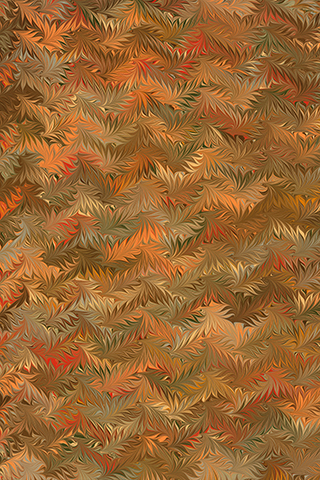 Eva van Breugel, Driebergen 2001, marbled paper
Eva van Breugel, Driebergen 2001, marbled paper
During the period up to World War I, the historical paper collections at the German Museum of Books and Writing focused mainly on coloured papers. Book designers at that time attached particular importance to beautifully designed bindings (endpapers, paper covers) and were consequently interested in historical and contemporary coloured papers.
The holdings encompass several collections, including those of the German Paper Museum and the special library of the German Book Traders’ Association in Leipzig.
The Seegers Collection
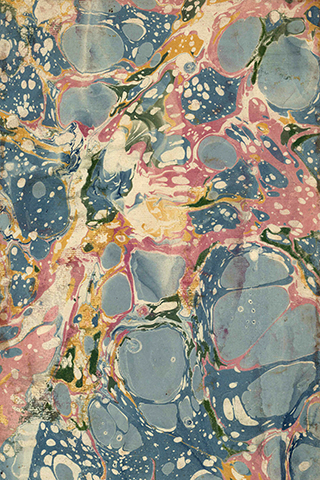 Marbled paper, 18th century, stone marble, multiple colours on a white background, manufacturer and production site unknown; the paper was presumably used in Italy
Marbled paper, 18th century, stone marble, multiple colours on a white background, manufacturer and production site unknown; the paper was presumably used in Italy
In 1901, the German Museum of Books and Writing acquired the private collection of dental technician Ernst Seegers from Hanover. Encompassing around 11,500 samples, the collection provides an extensive overview of European coloured paper production between the 17th and 19th centuries, particularly in Germany, France and Italy. It contains the most important varieties of paper made industrially and by hand: brocade, bronze-finished, chintz, paste and marbled papers along with a large number of printed and embossed fantasy papers.
The Bartsch Collection
In 1911, Viennese Hofrat (privy councillor) Franz Bartsch left his collection to the German Museum of Books and Writing. As a supplement to the coloured papers already represented in the Seegers Collection, it contains a wide range of coloured art papers dating from the period between 1890 and 1910, lithographic endpapers, and Japanese and Chinese papers and coloured papers.
Gallery of images from the Bartsch Collection
Ream imprints and ream wrappers
The collections of the German Museum of Books and Writing include around 150 original ream imprints, reprints and reproductions.
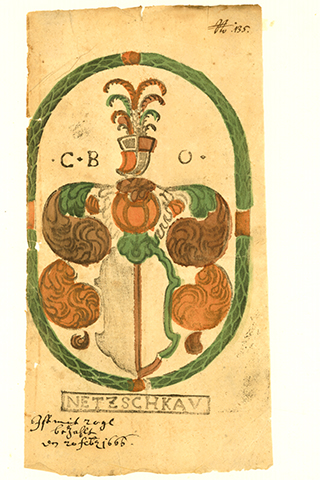 Ream imprint by Netzschkau (Vogtland, Saxony), original (1981/doc27), woodcut coloured with black ink. The ream wrapper depicts the coat of arms of the aristocratic von Bose family. The owner was Oberst (Colonel) Carl von Bose of the Electorate of Saxony, whose initials CBO (Carl von Bose, Oberst) are also printed on the wrapper.
Ream imprint by Netzschkau (Vogtland, Saxony), original (1981/doc27), woodcut coloured with black ink. The ream wrapper depicts the coat of arms of the aristocratic von Bose family. The owner was Oberst (Colonel) Carl von Bose of the Electorate of Saxony, whose initials CBO (Carl von Bose, Oberst) are also printed on the wrapper.
In the days when paper was still made by hand, it was packed in reams (a unit of quantity consisting of 480 sheets of writing paper or 500 sheets of printing paper) and marked with an imprint that provided information about the variety and origin of the paper. These ream wrappers are only rarely preserved. This makes the information they contain all the more interesting.
Ream wrappers can provide evidence of connections between the production site, paper mill, paper maker, denomination, watermark design, time of delivery, recipient and price.
The modern ream wrappers in which present-day manufacturers and wholesalers supply papers cut to format all follow this tradition.
International Bibliography of Paper History
Archival materials and documents on the history of paper
The collection of archival materials and documents on the history of paper consists of historic written and pictorial testimonies that bear witness to industrial, technical and economic aspects of the entire paper history.
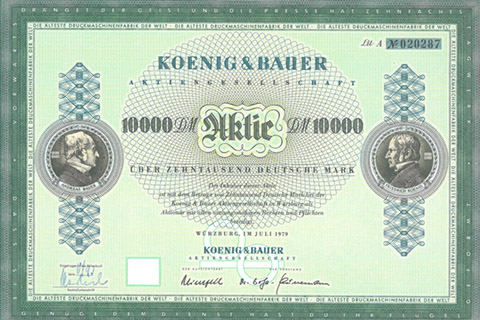 Koenig & Bauer Aktiengesellschaft, 1979
Thomas Wiege
Koenig & Bauer Aktiengesellschaft, 1979
Thomas Wiege
- Company archival materials
- Paper-making formulae
- Letterheads
- Postcards
- Share certificates and other securities
- Advertisements – technical drawings
- Registry of the German Paper Museum, Greiz (1957–1964)
- Documents from the estates of important paper history researchers (including Karl Theodor Weiss, Wisso Weiss, Dora Doss)
Contact: Ramon Voges
Last changes:
01.11.2021
Short-URL:
https://www.dnb.de/dbsmpapiersammlungen


